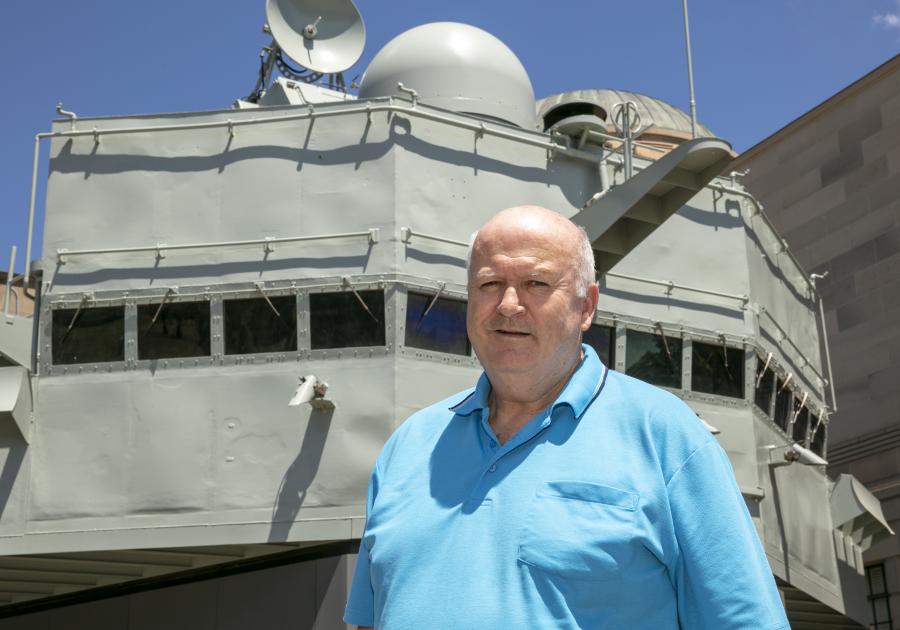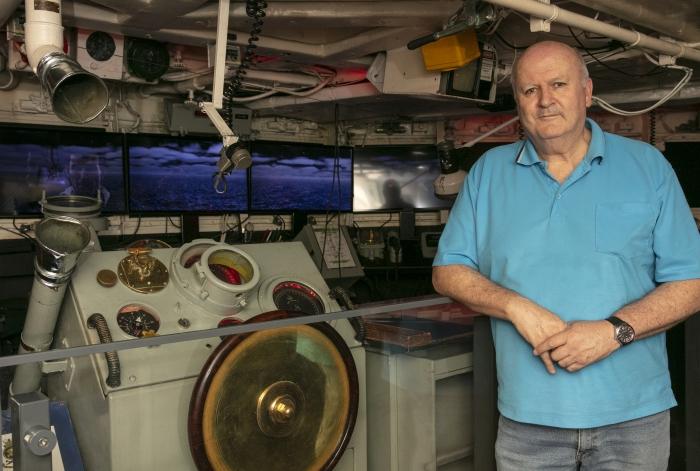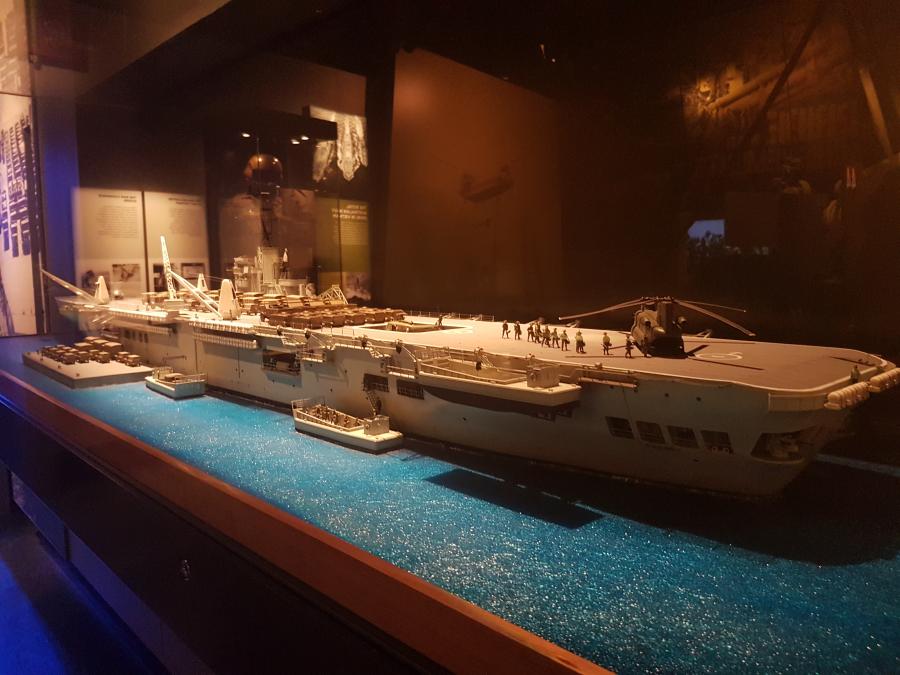'It's a labour of love'

Steve Hooke has been a voluntary guide for the past 10 years and will be speaking at an information session about volunteering at the Memorial.
Steve Hooke was just 19 years old when he was sent to Vietnam with the Navy.
“As a young fellow, I was driving one of the six landing craft on HMAS Sydney – the ‘Vung Tau Ferry’ – dropping soldiers and their gear off up on the beach, or up the river a bit, right near the end of the war,” he said.
“My dad was a returned soldier, and I joined the navy straight after high school… I always used to go to Anzac Day, and I remember watching my dad [and his mates march]… When I got back from Vietnam, I didn’t think of myself as a veteran, because I always thought they were.”
Now, more than 40 years later, Steve is a voluntary guide at the Australian War Memorial in Canberra.
“It’s a labour of love,” he said. “As a young naval officer, I got my ticket on the bridge of HMAS Brisbane [which is now on display at the Memorial]…
“It’s such an important place, and I guess that’s what it’s like for most of us here.”
Steve became a voluntary guide 10 years ago and will be speaking at an information session about volunteering at the Memorial on Saturday 8 December at 10 am.
“My wife knew I was interested in the War Memorial and she just happened to see this tiny little ad in The Canberra Times about an Information Day for aspiring volunteers,” he said.
“At the time, I’d just finished full-time service – nearly 40 years in the Navy – and I always wanted to be a part of it. My dad was a veteran, and I was here in Canberra … and she said, ‘Hey, you better get there today,’ and that was it.”
A decade on, he wouldn’t have it any other way. He remains passionate about volunteering at the Memorial and helps train new voluntary guides.
“It is such a special place,” Steve said.
“As a voluntary guide, you are the face of the Memorial in the eyes of the public… You don’t have to have been in the military or know all about military history … We can teach you that. All we want is people with the right attitude, who want to be a part of this special place, and want to help tell the story of the Memorial in a factual, accurate and stimulating way.”
Steve is one of almost 200 volunteers who currently donate their time, working in a variety of roles across the Memorial. They range in age from 18 to more than 90 and volunteer for roles in the Research Centre as well as Family History, Collection Services, and Art, but most work in Commemoration and Visitor Engagement.
“Volunteers come from all walks of life,” Steve said. “But there’s one unifying thing, and that’s this place here: they want to be a part of it and they want to represent this place and uphold and promote its very special, unique place in the world, and help maintain its reputation."
Each year, more than 100 voluntary guides provide free daily tours to about 60,000 visitors.
“So much of Australia is tied up in here," Steve said. "Our Director says it’s the soul of the nation, and I always tell my group of visitors that it is the most important secular shrine in Australia. It encompass everything: a shrine for commemoration, a world-class museum, and a research centre and archive … Nothing else in the world does what this place does.”

Steve Hooke on the bridge of HMAS Brisbane at the Memorial.
For Steve, it’s all about sharing the stories of Australians who served.
“I always tell people these relics aren’t here as trophies, they are here to tell the story of Australians and their experiences during war,” he said. “It’s about the men and women, and we can tell their stories through the objects that are here on display – the personal stories, right down to individuals. We can really honour the individuals that served … because this is about the people.”
For Steve, it’s the personal stories that matter. His father, Peter, served during the Second World War, as did his aunt and uncles.
“My dad was nearly killed in the war,” he said. “He served in the Middle East and New Guinea and he was decorated too for what he did, but he nearly died. He was wounded multiple times, and he even got married to Mum when he was wounded. The army gave him a week off to get married, honeymoon, and get back up into the war. That’s how tough it was in those days … but he nearly died after he was sent back to New Guinea. He was two years in convalescence because of his wounds, but he refused to be categorised as TPI – he told them to 'bugger off' because being a TPI would have prevented him from applying for a Soldier-Settler farm.”
Steve’s father was awarded the Military Medal for his actions in New Guinea and was mentioned in the official history. He had volunteered at the start of the war, as had his sister Joan, who was one of the last Army nurses to be evacuated from Greece.
“She went to the Middle East, and she was evacuated out of Greece after having survived some air attacks,” Steve said. “She survived that and came back and was nursing up in New Guinea and Australia. When my dad came back badly wounded, and nearly died, she nursed him for a while too, just by sheer accident. He was brought in and my grandmother had heard he’d been wounded … She wasn't sure if Dad was going to live or die, but it was Aunt Joan who told her that he was out of danger, but was going to be a long time recovering.”
Steve’s uncles also served in the Middle East and New Guinea, and one was a Rat of Tobruk. “It’s fairly typical of many families of that generation,” he said. “They thought it was their duty to go and volunteer and join up.”
As a volunteer at the Memorial, Steve finds it particularly rewarding to meet veterans and their families.
“Almost every day something stands out, and this is one of the wonders of this place,” he said.
“I had some descendants on a tour and they said they thought their great-great uncle was a bit of a hero, and that he had got a medal in the war… I thought that the name rang a bell, so I was able to take them to the Hall of Valour and show them his photograph, and his medal – a Victoria Cross – and they were just blown away.
“It was only a week later Harry Murray’s descendants were in a group I was guiding. He was the highest decorated Australian in the First World War, and I was able to show them his old medals and his Victoria Cross, and hear some of their recollections of Harry. It's those sort of experiences that make this place so special…
“It really is a privilege to be here, and we use that word a lot, but I’m always blown away. Every day is different because of the people you meet, and it's often humbling, and really, that’s what it’s about, we are servants of this place…
“It’s powerful stuff for people, and these things tend to happen all the time.”
He encourages anyone who is interested in volunteering at the Memorial to attend the information session to hear about the range of opportunities and experiences available. Attendees will hear presentations from line managers and volunteers and learn about the training and requirements of being a volunteer.
Steve plans to keep volunteering at the Memorial for as long as he can.
“I love it, or I wouldn’t be here,” he said simply. “For those who have served in uniform, you never stop being a sailor, you never stop being a soldier, and you always have your mates… Serving in this place seems like a natural transition to ongoing service to the public...
“The people who come here put their heart and soul into it, and they are the front line of the Memorial … It genuinely is a labour of love, and that is what binds most of us.”
For more information about the information session and volunteering at the Memorial, visit here.

A model of HMAS Sydney, the ‘Vung Tau Ferry’, on display at the Memorial.